Unit 9 - Linux and Ubuntu
Introduction to Linux and Ubuntu
Learning Objectives
Understand the basics of Linux, including the nature, architecture, and differences/
similarities with Windows
Linux overview
Common Linux terms and definitions
Linux system architecture
Differences and similarities with Windows
Gain an introduction to the Linux command line environment
- The “sudo” command
UNIT 9 – SECTION 1
What is Linux?
A Family of Operating Systems
Linux refers to a family of operating systems modeled off of Unix
Can perform many of the same functions as Windows or OS X
Built in a collaborative, open-source environment
Anyone may use, modify, or distribute the Linux kernel
Anyone can develop software to run on the Linux kernel
Many programmers collaborate to develop or improve Linux programs
Many Linux operating systems and add-on programs are free
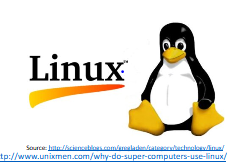
Linux Kernel
A kernel is the core component of an OS
Windows operating systems have kernels, but since they are not open-source or packaged separately for programmers to build off, they are less-often discussed
Manages system resources (Memory, Processes, Input and Output Devices)
When a user does something in the shell (the OS’s user interface and applications), the kernel translates the command and prioritizes it against other requests for resources, so that it can be understood and executed by the CPU
Different Linux Operating Systems
- There are many different flavors (OSes) built off the Linux kernel
- Ubuntu: Most popular flavor. It is free and is the most user-friendly.
- Mint: A popular variation of Linux.
- Red Hat: Designed by a company that develops specialized flavors for government and big business.
- Fedora: An open-source, free version of Red Hat. Used frequently as a test bed for Red Hat programs.
- These flavors are similar at the basic level but can have very different interfaces and specialized commands.
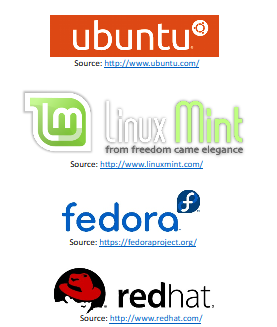
Differences Compared To Windows
Often free or less expensive
Desktop environment and GUI elements change
Some tasks can only be run in the command line
Less malware on Linux
Certain hardware cannot work with Linux
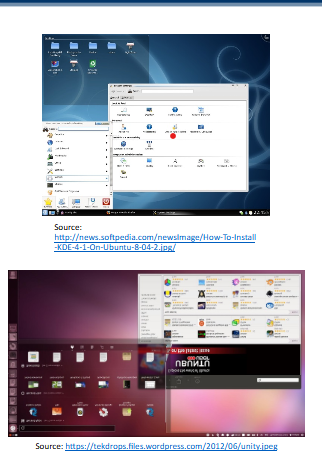
Similarities to Windows
Can be servers and workstations
- Linux servers and workstations are more similar than Windows ones. Linux servers come pre-installed with server applications
Can complete similar tasks
- There are Linux programs that function like to Microsoft Office (LibreOffice), Outlook (Thunderbird), etc.
Are stable and have significant support
Subject to very similar vulnerabilities
- Linux systems are targeted less frequently by malware, but still have many of the same vulnerabilities and patches (firewalls, password policy, etc.)
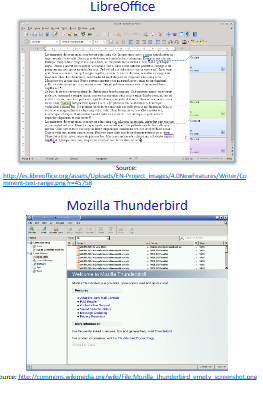
Unit 9 – Section 2
Ubuntu Terminology and Concepts
The Root Account
Account types: User and Root
Root – The Linux Administrator account
Like the built-in Administrator in Windows, Linux comes with a built-in root account
A system can have multiple root accounts
Users can switch whether their actions are carried out as a user or root
When someone enacts root permissions, he or she can access all the files and run all commands on a system, as well as set policies for other users
Root actions require a password in both GUI and command line
Authentication vs. Authorization
- Root users are authorized to do many different tasks, but they must first authenticate their identity by entering their password
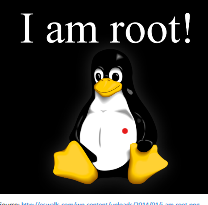
Ubuntu File System
Different from the Windows file system
- Does not specify on which drive a folder is stored and uses forward slashes (/) to identify root directories
Example:
Windows: C:\Documents\hello.txt
Linux: /home/CyberPatriot/hello.txt
Important folders:
/home: stores each user’s documents, media files, etc. Users can only access their own folders, unless they have enacted root permissions.
/boot: contains startup files and kernel files. Should not be modified unless you are an expert user.
The file system can be accessed by clicking the file cabinet on your Ubuntu menu bar
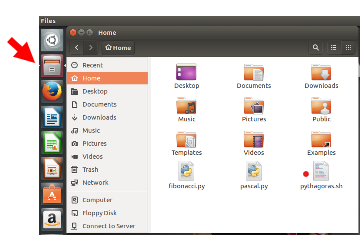
Adding and Removing Software
Linux software is bundled into packages
Packages are managed by package managers
In Ubuntu, the package manager is called “Ubuntu Software Center.”
It looks and functions a lot like Mac’s App Store
Many programs are free
To access Ubuntu Software Center, click the shopping bag on your Ubuntu menu bar
Users must enact root permissions to install, uninstall, or modify software
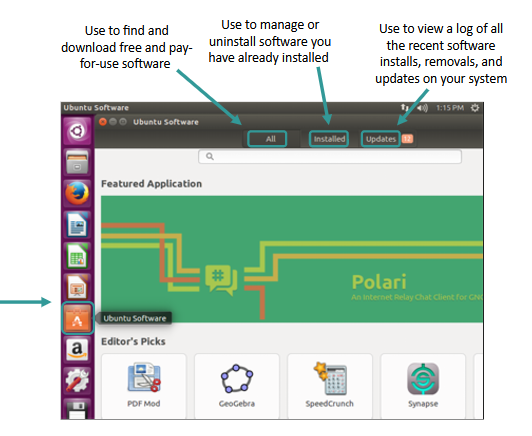
Unit 9 – Section 3
Introduction to Ubuntu Command Line
Linux Filesystem
Linux files are stored in directories, which are the same as folders in windows
Linux filesystem tree
Base or trunk of the tree is the root directory (/)
Branches of the tree are directories
Leaves of the tree are files
Linux commands, files, and directory names are case sensitive
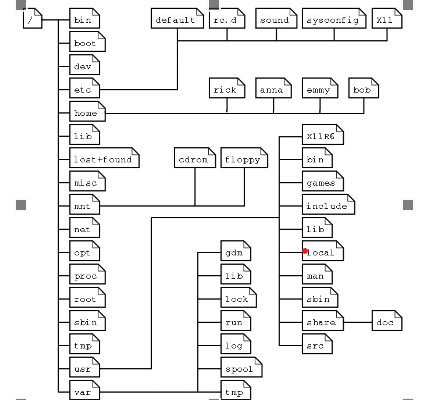
Command Line Pros and Cons
Pros
Provides the user more control
- Unlike the GUI, which pre-programs certain tasks, command line allows you to send more detailed and customized commands
Only option for some tasks in Ubuntu
Saves clicking time because it just requires a keyboard
Uses less of the computer’s processing power than the GUI (no animations or graphical processing)
Can be made easier with scripting
Scripts are sequenced lists of commands that allow users to send multiple commands at once
Can be used for routine tasks like backing up files, monitoring system, and quickly gathering information about memory and processes
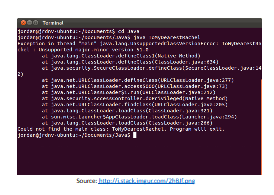
Cons
Not as user-friendly as GUI
- Requires memorizing commands or using a reference
Harder to multitask
- Having multiple command line windows open at once can be confusing, since they look nearly identical
Accessing The Command Line
Terminal is the tool used to access the Ubuntu Command Line
Click the Ubuntu button
Type terminal
Press Enter or click the icon labeled Terminal
ORPress Ctrl-Alt-T

Using Terminal
When typing commands in Terminal, it is very important to pay attention to capitalization and spaces
Hitting Enter will execute your command and hitting Ctrl+D will close any commands you have running or exit the Terminal
There are numerous Ubuntu command databases and command line tutorials online. Here are a few sites:
Command Syntax
Command: tells the computer what you want it to do
All other components of the syntax depend on what the command is
The “cat” command creates, displays, or copies files
Option: customizes the output of the command
“-n“ told the computer to add a number to each line of text in the file you created
The effect an option has varies by command
Not required for all commands
Operator: directs the output of the command
- Not required for all commands
File Name/Location: Tells the OS to which file you want the command and options to happen
Like English sentences, Command Syntax can get very complex
Basic Navigation Commands
pwd
“Present Working Directory”
Prints out your current working directory
ls [FILE]…
“List Segments”
Optional file/directory paths as an argument
cd [dir]
“Change Directory”
Optional directory path as an argument
Absolute paths
Starts from the root directory (/)
cd /home/cyberpatriot/Music
Relative paths
Start from the current directory (.)
cd ./Music or just cd Music
One dot (.) indicates the current directory
Two dots (..) indicates the parent directory
Command Manuals and Usage
man [section] page
- “Manual”
- Displays the manual for a command
Type man man and press Enter
Displays the manual for the command “man”
Use the arrow keys or PgUp/PgDn to scroll up and down
Type q
- Exits man

Command Manuals and Usage
Many commands have a --help or –h option
Type ls --help and press Enter
- Displays help for the command ls

File Contents and Output Redirection
cat [FILE]...
“Concatenate”
Concatenate files and prints to standard output
Commonly used to print the contents of a single file
file [FILE]...
- determines the type of a file
echo [STRING]...
- displays a line of text in the command line
[command] > [FILE]
The standard output of any command can be redirected to a file with a “greater than” symbol
This will create a new file or overwrite an existing file
Sample Command
- Note: If the Linux Operating System does not have a CyberPatriot Directory, use another directory
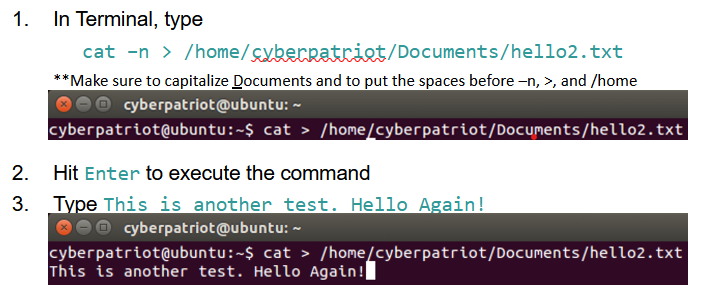
Sample Command (cont.)
- Close Terminal and open the Home Folder by clicking the orange folder on the Ubuntu menu bar
- Navigate to the Documents folder
- Double-click the hello2.txt file
The commands you just entered created this text document
- It includes the file name you selected, the text typed, and a “1” at the beginning of the line of text. The next few slides will examine why.

The sudo Command
Allows an authorized user (one with root permissions) to temporarily elevate their privileges using their own password instead of having to know the password belonging to the built-in root account
This command must be used to perform administrative tasks (e.g. adding a user account)
Example: To add “archimedes“ as a user on your system, type adduser archimedes and hit Enter
You will get the error message below because you have not authenticated yourself
Note: user names must be lower case

The sudo su Command
The sudo su command is a variation of the sudo command
- It tells the command line that you want to run all of the subsequent commands in your current session as root, so that you do not have to enter the sudo command and your password each time